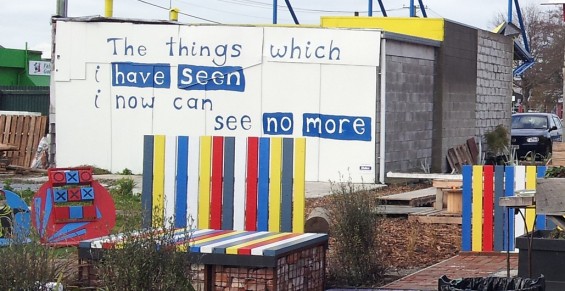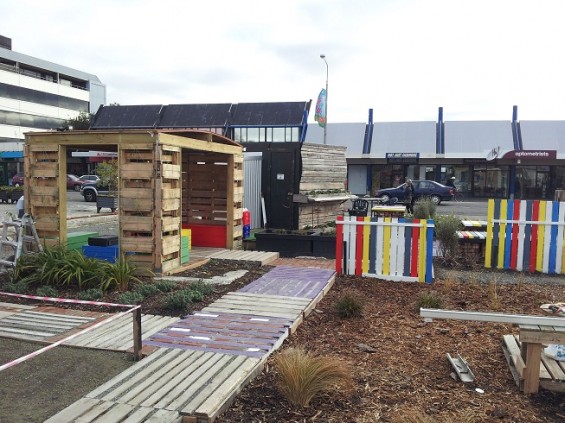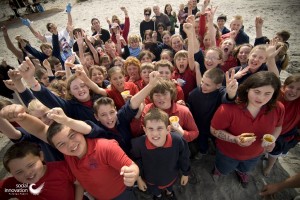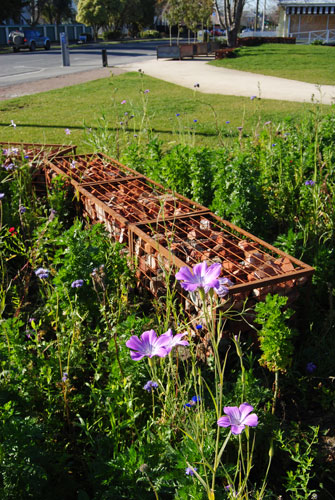Greening the Rubble: Planting the seeds of freedom – by Steve Carter
 “It’s a terrific thing to be involved in … I feel like it’s kind of a dream job really.”
“It’s a terrific thing to be involved in … I feel like it’s kind of a dream job really.”
It’s always so refreshing to hear people express such passion for their work. On a beautiful, sunny early spring day, hanging out in a little gazebo fashioned from recycled
pallets and surrounded by temporary gardens where once stood a retail store, the words capture the atmosphere of the best of Christchurch resilience.
I am chatting with Jonathan Hall, now a few months into his role as Sites Supervisor with Greening the Rubble, another of those vanguard post-quake ‘can-do’ projects that define how this city is responding to disaster. It’s pretty clear that he really does love what he gets to do with the project. “The feedback I get from volunteers and the public,” he says, “Makes me feel like I am really involved in something that is making a difference.”
For the uninitiated, Greening The Rubble is something of a philosophical counterpart to Gap Filler, the landscaping-centred foil for their conceptual art hi-jinks. Both emerged as immediate responses to the September 2010 quake and both cranked up into higher gear after the devastation of February laid low so much. If there are obvious differences in the specifics of their work, the vacant-space parallels bind them together as co-conspirators and their mutual existence has always been entirely complementary.
The ‘gap’ in which Jonathan and I are sitting is a perfect example. A small Sydenham section on the corner of Colombo and Wordsworth Streets, this could so easily be just
another dead zone of inert materials and the exposed faces of the next door buildings.
Instead, the plot is an orgy of colour and surprise: raised beds filled with neat plantings; rainbow-painted seats, pathways and picket fences; a huge artwork quoting William Wordsworth (“The things which I have seen, I now can see no more”); and, of course, the Gap Filler temporary office and Gap Golf hole number 1. There’s even the Coffee Zone cart complete with outdoor seating, an early opportunist business, drawn to and now an integral part of this vibrant reclaiming of space.
As Jonathan puts it, “What I like about is that it’s quite anarchic – you have the freedom to do something like this. In Christchurch it seems we have had so much of our freedom and rights bound up in red tape or taken away, and people are unsure about what’s happening … but this is so free and anyone can have an input.”
Importantly, this site, like all the others, acts as a magnet that draws people to consider possibility and recognise the opportunity to get involved in the reclaiming of space and the redrawing of lines. Jonathan enthuses that, “Projects like Gap Filler and us, doing little quirky things like this, explorations into what you can do with space … it triggers something in people and makes them more open to these sorts of ideas.”

Not only do they give people hope and pause in the face of so much depressing scenery and challenging day-to-day living, they remind us that we do have some control over our circumstances. As Jonathan says, “Christchurch, in the past, has been so conservative but now there is so much happening. More than there ever has been, and it’s going to get into the psyche of the city.”
Through an inadvertent colonisation of the name, ‘gap’ projects have become synonymous with Gap Filler, but Greening the Rubble are very much equal bringers to the party. All over the city, sections have been planted, landscaped and otherwise dressed up as part of the revisioning of the damaged spaces in our environment.
It’s that principle of reimagining our immediate locale to focus attention, if only fleetingly, away from all the damage and drear, not to delude ourselves that the destruction hasn’t happened, but to offer hope for the future through appeals to use fresh eyes.
Spurred by the leadership of the key players such as Gap Filler and Greening the Rubble, communities across the city are engaging with their vacant spaces to take control of this process and Jonathan is inspired by the sense of forward momentum that all these projects are engendering: “It’s often said that out of adversity comes opportunity and that is definitely true in Christchurch, I feel.”
With the Residential Red Zone now starting to produce greater numbers of vacant plots out in the suburbs, the opportunities (some might say responsibilities) to do something bold and progressive are palpable. There is a clamouring for large areas to be given over to spaces of reflection, open public parklands and community gardening initiatives.
All of which the strong advocacy of groups such as Greening The Rubble should help to ensure, by leveraging the credibility they have established by their constant and important contributions of the last two years.
There’s tentative talk here of ‘turning a corner’ and the feeling that, with aftershocks fewer and further between, the real work is just beginning … can really begin in earnest. Spring has sprung and the city feels rich with possibility and alive with new ideas.
Not all of them will be managed by the teams at Gap Filler and Greening The Rubble, but all will certainly be inspired in part by their trail-blazing brand of celebratory anarchy.
Let the greening begin.
If you want to find out more about Greening The Rubble, or to find out how you can get involved as a volunteer, visit the website at: http://greeningtherubble.org.nz/wp/ or shoot by their Facebook page: http://www.facebook.com/greeningtherubble
Read the inspiring stories of our Christchurch sponsors:
 SHAC – The Sustainable Habitat Challenge – is a network of architects, builders, engineers, designers, building scientists, students and young professionals interested in taking positive action in their communities today.
SHAC – The Sustainable Habitat Challenge – is a network of architects, builders, engineers, designers, building scientists, students and young professionals interested in taking positive action in their communities today.
On the 2-3 May 2012, SHAC presented the 2nd annual workshop on micro-architecture at the Christchurch Polytechnic Student Centre. Sixty attendees discussed temporary architecture, simple buildings, and the reuse of building material.
“People cherish their culture through recycling” – those are the words of Wang Shu, the 2012 winner of the Pritzker architecture prize. The demolition of red stickered housing and CBD buildings does not have to mean the eradication of Christchurch’s history or culture – nearly all materials can be reused in new construction, incorporating local memories and fusing the past with the present.
What is permanent in this land of earthquakes? In San Francisco, the Palace of Fine Arts was built in 1915 as a temporary building for the Panama-Pacific Exposition and still stands today as an icon of the city. From the cardboard cathedral to the convention centre – how long will they serve us?
“Simple buildings are key for affordability” said Canadian architect Brian McKay Lyons, recently interviewed on Nine to Noon with Kim Hill. Lyons, from Nova Scotia, says “simple buildings are what we farmers and fishermen build when we can’t afford to get things wrong”
This symposium brought together elements of the growing Regeneration movement – people working together to take positive action in their communities.
Community Rebuild – for the Whole House Reuse project Juliet Arnott
Community Development – Joshua Durrant, Jess Smale, Sophie Moore
Positive Action – Gapfiller Trust
 YTONG® is an alternative building system made from light-weight Aerated Autoclaved Concrete (AAC). It was invented in Sweden in 1923 and further developed under the YTONG® brand it turned into a world-wide success.
YTONG® is an alternative building system made from light-weight Aerated Autoclaved Concrete (AAC). It was invented in Sweden in 1923 and further developed under the YTONG® brand it turned into a world-wide success.
Environmentally friendly and non-toxic – From the manufacturing process to shipment, construction, and waste disposal YTONG® is in ecological balance.
Good sound absorption – effective sound barrier – The natural air cushion formed in the high-pressure steam curing of AAC can absorb the most possible noise.
Ensures high standard of well-being – YTONG® reduces temperature differences and humidity fluctuations and so ensures a comfortable and healthy room atmosphere.
Excellent workability – It is easy to erect a solid masonry structure quickly and precisely. Only few tools and implements are necessary.
Outstanding thermal insulation – Keeps buildings cool in summer and warm in winter saving on heating and air-conditioning.
YTONG® is fireproof and has a high fire rating – AAC is resistant to high temperatures for a longer period of time than any other solid building material. YTONG® is especially chosen for fireproof walls in commercial buildings.
Performs well in earthquakes – Thanks to its low weight and its plastic deformation properties the destructive force of earthquakes can be minimised.
 Social Innovation is a small, hardworking community engagement agency based in Christchurch. They work with leading non-profits, changemakers, progressive companies and government to mobilise everyday New Zealanders. Their expertise in this area comes from grassroots innovation on large-scale community action projects, including the Student Volunteer Army, A Day at the Beach Festival, Love your Coast and a number of other public participation initiatives. They know how to scale initiatives and achieve big results with large numbers of stakeholders.
Social Innovation is a small, hardworking community engagement agency based in Christchurch. They work with leading non-profits, changemakers, progressive companies and government to mobilise everyday New Zealanders. Their expertise in this area comes from grassroots innovation on large-scale community action projects, including the Student Volunteer Army, A Day at the Beach Festival, Love your Coast and a number of other public participation initiatives. They know how to scale initiatives and achieve big results with large numbers of stakeholders.
 kiwi folk heroes like Kate Sheppard combined with the sheer power of modern technology. At the heart of what they do is supporting everyday New Zealanders to take action and participate fully in public life, in turn increasing the proportion of citizen’s who know that they can make a difference to the way things are.
kiwi folk heroes like Kate Sheppard combined with the sheer power of modern technology. At the heart of what they do is supporting everyday New Zealanders to take action and participate fully in public life, in turn increasing the proportion of citizen’s who know that they can make a difference to the way things are.Their services include strategy, leadership training, volunteer coordination & management, media and communications, project management and fundraising. Find out more at www.socialinnovation.org.nz or make direct contact via their studio-line on 03 337 0861
Ph: 03 337 0861 or [email protected]
The Local Good News initiative is officially endorsed by Mental Health New Zealand.
Got good news to share about your social enterprise? Join this inspiring line up of Christchurch sponsors, email [email protected]
loading...
loading...
Tags: christhchurch






Voices of our community